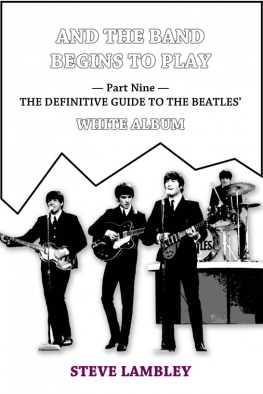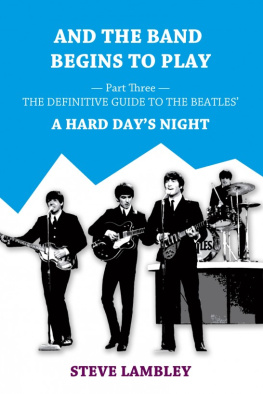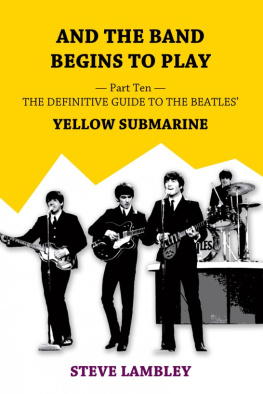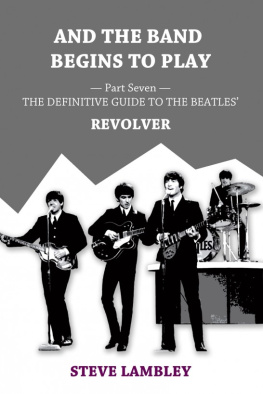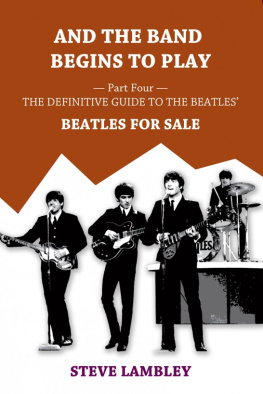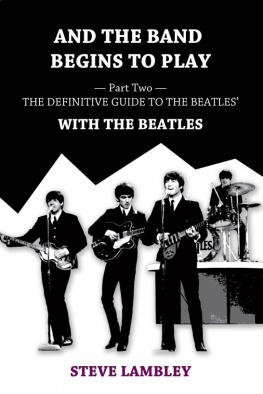AND THE BANDBEGINS TO PLAY
Part Five The Definitive Guide to the Beatles HELP!
by
SteveLambley
Published bySLIDE Books
Version 2.0
Steve Lambley2014
All song lyricsremain the copyright of their respective owners, and are quoted forthe purposes of scholarship, under fair dealing and fair usagelaws. No infringement is intended.
No part of thisbook may be reproduced in any form without written permission fromthe copyright holder.
SmashwordsEdition, Licence Notes
This ebook islicensed for your personal enjoyment only. This ebook may not bere-sold or given away to other people. If you would like to sharethis book with another person, please purchase an additional copyfor each recipient. If youre reading this book and did notpurchase it, or it was not purchased for your use only, then pleasereturn to Smashwords.com and purchase your own copy. Thank you forrespecting the hard work of this author.
Table ofContents
Single release
Parlophone R 5265 Released 9 April 1965
Ticket To Ride
[Lennon-McCartney]
Recorded 15 February
Mixed 18 February (mono), 23 February (stereo)
John leadvocals, rhythm guitar
Paul harmony vocals, bass, lead guitar
George harmony vocals, rhythm guitar
Ringo drums, tambourine
The new singlefor 1965, recorded during the first studio session of that year,was Ticket To Ride. The choice of the track for the groupsfollow-up to I Feel Fine was interesting and courageous. While ithas a similar electric setting to its predecessor, the style of thearrangement and the emotion contained within the song are markedlydifferent. The joyful, ebullient, open, carefree sing-along of theearlier song has become earnest, weary and disconcertinglyarrhythmic. It is the groups first downbeat single. Whether a songsuch as The Night Before would have been a safer commercial betis arguable, but the gamble if such it was paid off and TicketTo Ride was a UK and US number one. Nevertheless, BeatlesBook ran a poll in 1965 which revealed that the least populartrack with both UK and overseas readers on the entire Help!LP was Ticket To Ride.
The despondentlyric has an emotional intensity not evident in previous songs. Forthe first time, John genuinely seems to mean it moreintently than in Misery, Not A Second Time or even Im ALoser. But he is still not an out-and-out victim: he almost hasthe upper hand, hes going to decide how he feels, no-ones goingto decide it for him. The deterministic avoidance I thinkIm gonna be sad / I think its today allows him theillusion of maintaining a vestige of control. Because its morethan the fact the shes going away, and that she felt cloistered byhis presence. He is the injured party, and the lyric justifiesitself during the bridge she ought to do right by me. Theappearance of the downcast, despairing Ah before shes got aticket to ride towards the end of the song becomes as fundamentalas the off-hand, wondering Oh but youre lovely in The Way YouLook Tonight. Both show realisation dawning, but invokingdiametrically opposed emotions.
Althoughmainly Johns song he dismissed Pauls contribution as solelythe way Ringo played the drums Paul also claimed involvement inthe composition. We sat down and wrote it together. I remembertalking about Ryde [a resort on the Isle of Wight where Paulscousin Bett and her husband ran a pub] but it was Johns thing. Wewrote the melody together; you can hear on the record, Johnstaking the melody and Im singing harmony with it. Wed often workthose out as we wrote them. Former Daily Mirror journalistDon Short has made the unlikely claim that John once told him itwas a term he had invented for the cards given to Hamburgprostitutes in the 1960s giving them a clean bill of health, buteven Short concedes, he could have been joking.
And thenagain, John had passed his driving test on the morning of recordingthe track.
It is mostlikely that the basic idea for the song came from John GeorgeMartin remembers John strumming the unfinished song during theskiing holiday that he and Judy shared with John and Cynthia inJanuary 1965 and that Paul then joined him at Kenwood shortlybefore the recording session to finish the song, finalising thewords and working out the harmonies.
Paulsfingerprints are also over the unusual coda. We picked up one ofthe lines, My baby dont care, but completely altered the melody.We almost invented the idea of a new bit of a song on the fade-outwith this song; it was something specially written for thefade-out, which was very effective but it was quite cheeky and wedid a fast ending. It was quite radical at the time.
Paulsinfluence on the execution of the song is also particularly marked.As well as playing bass on the track, Paul plays a lead guitar his are the Epiphone Casino licks that follow the chorus thefirst time anyone apart from John or George had played lead. If thesong had been recorded later, it is possible he would also havetaken it upon himself to play the drums, but for now he restrictshimself to suggesting a pattern for Ringo to play. According toengineer Norman Smith, Pauls role was becoming virtually that ofproducer-in-the-studio. Paul was a very great influence in termsof the production, especially in terms of George Harrisons guitarsolos and Ringos drumming Paul had a great hand in practicallyall of the songs that we did, and Ringo would generally ask himwhat he should do. Smith also implies that by 1966, Paul hadalready played the drums on a Beatles track.
Although theTicket To Ride pattern was suggested by Paul, the execution issupremely Ringos. Ringo later said of his drumming I try not tomove at all throughout a whole song, embellish or decorate at all,keep it really, really simple. And that is what he does in TicketTo Ride, where his drumming is very restrained and very effective.Throughout verse and chorus the lilting figure is provided by theaccented snare matching the tambourines steady backbeat, butanticipating the fourth beat by half a beat.
This chiming,strident combination of guitar, bass and drum contributions givesthe song a great deal of its character. John called it one of theearliest heavy-metal records made and it must have come acrossthat way in concert more so than on record. The classic Beatleguitar sound is courtesy of Georges original 1963 Rickenbacker12-string, which he plays for one of the last times on this track.It was soon replaced by a later model, presented to him during theUS tour of August 1965. The track also boasts newly acquired FenderStratocasters played by John and George. George was tiring of thesound of his Gretsch and decided he needed to upgrade. John wentalong with George, and so Mal Evans was told, go and get us twoStrats. Evans appeared with two identical pale blue 1961 models,and the pair began recording with them straightaway.
The lopsided,disconcerting drumming is a copy of Georges opening guitar riff,and for much of the song, the lead guitar echoes Pauls bass withan insistent, open A. The riff itself is quite different from IFeel Fine in being more regular and arpeggiated and lessblues-influenced, and so less obtrusive.

The strength ofthe song is hinted at by its maintaining the tonic for the whole ofthe first ten bars. Throughout the verse, the drum, guitar and basspattern remains the same. The tension is released when she goesaway, and the song finally moves to BmE (IiiV). The refrain thenmoves to the relative F# minor, and introduces a surprisingF#mGmaj7F#m (vibVII7vi) before finally resolving back to A,the Gmaj7 drawing attention to itself by supporting a #11th in themelody on the final C# of ride. The veneer cracks again here withan impatient roll on the tom-tom, but this diminishes as the songprogresses, until it becomes a single snare whack the last timearound. The double-time bridge revolves around D7 and E (IV7V),the shuffling tempo and hyperactive tambourine returning for thecoda.
Next page
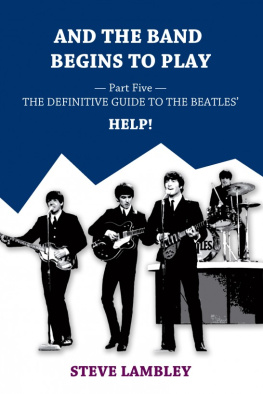
![Lambley - And the Band Begins to Play: [Part9 The Definitive Guide to the Beatles White Album]](/uploads/posts/book/213743/thumbs/lambley-and-the-band-begins-to-play-part9-the.jpg)
![Lambley - And the Band Begins to Play: [Part1 The Definitive Guide to the Beatles Please Please Me]](/uploads/posts/book/213741/thumbs/lambley-and-the-band-begins-to-play-part1-the.jpg)
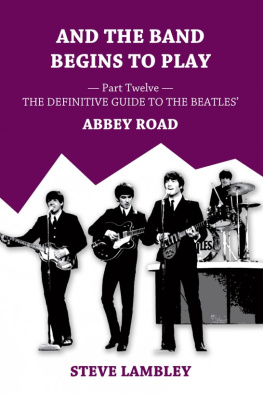


![Lambley - And the Band Begins to Play: [Part6 The Definitive Guide to the Beatles Rubber Soul]](/uploads/posts/book/213742/thumbs/lambley-and-the-band-begins-to-play-part6-the.jpg)
